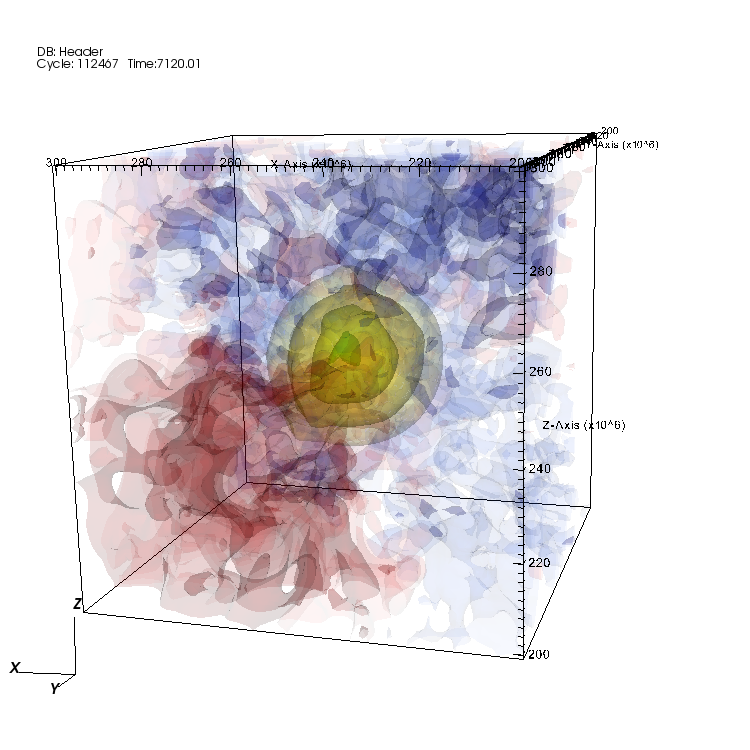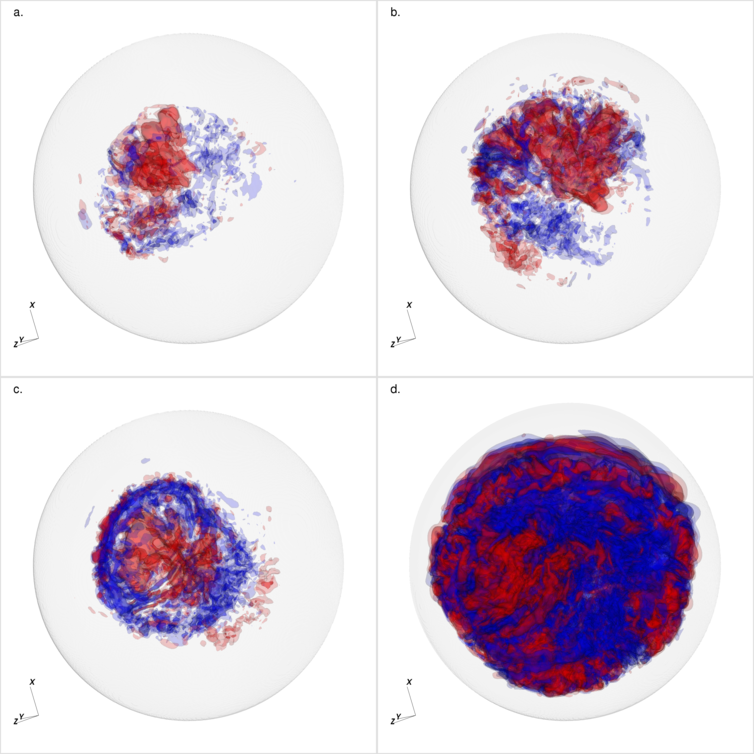
Home |
News | Research | Publications |
People |
BoxLib |
Links |
Downloads |
Full-Star Simulation of White Dwarf Conection Using MAESTRO
Type Ia supernovae (SNe Ia) are the largest thermonuclear explosions in the universe. Their immense light output allows them to be used as cosmic distance indicators, and observations of SNe Ia have led to the discovery of the acceleration of the expansion of the universe. In spite of the central role these observations play in constructing our model of the universe, our understanding of SNe Ia is still far from complete. An important open question is how, and under what conditions, ignition occurs. Early simulations of SNe Ia have shown dramatic differences depending on the assumption that is made about ignition.
Using MAESTRO we have performed the first 3D full-star simulations of convection in a white dwarf leading up to the ignition of a Type Ia supernova. These simulations are initialized with a 1D spherical profile, generated by the Kepler stellar evolution code, that defines the initial thermodynamic state of the star several thousand seconds before it explodes. In this initial profile the inner portion of the star is nearly isentropically stratified and the outer portion is stably stratified. While scientists believe that convection proceeds for centuries before ignition, in the last few hours before explosion reactions near the center of the star intensify and the convection becomes much more vigorous. This convective flow in the inner part of the star appears to have a dipole structure. When plumes reach the stable, outer portion of the star, internal gravity waves are generated. As the simulation progresses through many convective turnover times, the burning continues to intensify, and the dipole flow pattern also increases in intensity, with an orientation that is constantly shifting direction within the star. (The dipole was identified in previous simulations; however, our simulations were the first to observe the changes in direction and to quantify this motion.) Finally, after almost two hours of physical time, the convective motion is no longer able to balance the energy generation of the star and the first flame ignites. The ability to accurately simulate conditions leading up to ignition represents a major step forward in the drive to understand SNe Ia and to relate current theory to observation for these important phenomena.
| This image shows the radial velocity as well as the nuclear energy generation (yellow/orange/green contours) close to the time of ignition. Only the inner (1000 km)3 are shown. |

|
Details of this calculation can be found in
 M. Zingale, A. S. Almgren, J. B. Bell, A. Nonaka, and S. E. Woosley,
"Low Mach Number Modeling of Type Ia Supernovae. IV. White Dwarf Convection",
Astrophysical Journal, 704, 196-210, 2009.
[pdf]
M. Zingale, A. S. Almgren, J. B. Bell, A. Nonaka, and S. E. Woosley,
"Low Mach Number Modeling of Type Ia Supernovae. IV. White Dwarf Convection",
Astrophysical Journal, 704, 196-210, 2009.
[pdf]
Questions?
Contact Ann Almgren or Andy Nonaka.Acknowledgements
This work was supported by the SciDAC Program of the DOE Office of Mathematics, Information, and Computational Sciences under the U.S. Department of Energy under contract No. DE-AC02-05CH11231 to LBNL and by a DOE Office of Nuclear Physics Outstanding Junior Investigator award (No. DE-FG02-06ER41448) to Mike Zingale at Stony Brook Univeristy.
